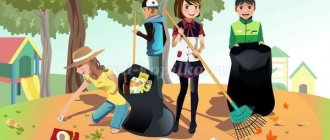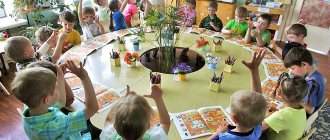Parent meeting in the secondary group “Ecology and us”
Elena Syusyura
Parent meeting in the secondary group “Ecology and us”
Target:
1. Increase parents’ interest in environmental education of children and ecology in general.
2. Involve parents in the work of the group and kindergarten to form an environmental culture for preschoolers.
Meeting plan:
1. Conversation “What is environmental education?”
2. Game "Chamomile"
3. The word is a relay race
4. Preparation for the summer period, assistance from parents in arranging and landscaping the site.
5. Miscellaneous.
Progress of the meeting:
Parents sit down, fill out a registration sheet, while music from the program “In the Animal World” plays.
Educator: Good evening, dear parents! Thank you for taking the time to come to the parent meeting. After all, the leading role in raising a child belongs to the family and its way of life. The family is a source that nourishes a person from birth, introduces him to the environment, and gives him the first knowledge and skills.
More and more often we hear and pronounce the word “ecology”. It is advisable to start environmental education from early childhood, developing an understanding of the beauty of nature and love for it.
What is environmental education? (Parents' answers).
This is the knowledge of living things that are close to the child, in interaction with the environment, and on this basis the development of the correct forms of interaction with him. By attracting children to close communication with nature, to the knowledge of communication with nature, knowledge of the world of plants and animals, we, adults, contribute to the active development in children of such qualities as kindness, patience, hard work and mercy. These traits, laid down in childhood, will firmly become part of a person’s character and become his foundation. Then you can be calm for nature and the younger generation.
Preschool childhood is the initial stage of the formation of a person’s personality, his value orientation in the world around him. During this period, a positive attitude towards nature, the “man-made world”, towards oneself and the people around them is formed.
“Life today is impossible without environmental knowledge. We, people, need them like air, like a cure for a disease, the diagnosis of which is indifference to our common Home, to Nature” (Valery Arkadyevich Alekseev - historian and philosopher).
Nature itself makes it possible to comprehensively develop a child, broaden his horizons by showing the relationships in nature, involve children in joint activities, encourage the child to sympathize, empathize, and desire to help with deeds. What will help us first? (Parents' answers).
Yes, these are various walks and observations, during which it is necessary to teach the child to draw independent conclusions while observing weather phenomena. Maintain interest in the surrounding world, animate and inanimate natural phenomena.
While walking, observe what is happening in nature, enrich children with new knowledge, which will be the basis for a conscious attitude towards it, and also develop a sense of beauty in children.
Environmental education is a continuous process of training, education and development of a child, aimed at developing his environmental culture, which manifests itself in an emotionally positive attitude towards nature.
As practice shows, modern preschoolers have a large amount of knowledge about nature. However, this knowledge is often formed spontaneously, under the influence of television programs, advertising, and cartoons. Only in the process of purposeful work of the kindergarten and parents can an ecological culture, ecological thinking, and environmental consciousness be formed in children.
Happiness is being with nature, seeing it, talking to it. We must cherish this happiness and teach it to our children.
Nature is an inexhaustible source of aesthetic feelings and experiences. You cannot love nature without knowing it. The more you know, the more you understand and love. In a few years, our children will become adults. And responsibility for the life of our society, for the fate of our land will fall on their shoulders. And it depends on us adults whether they will love and take care of our nature, whether they will be able to foresee the consequences of their activities in the ecological environment.
Seasons... They usually replace each other, and over the years we adults cease to be surprised and rejoice at how the colorful splendor of autumn gives way to the severity of the black and white graphics of winter, how the barely visible watercolor spots of spring are overshadowed by the generous multicolor palette of summer. And only sometimes the smell of rotten leaves or the bizarre shape of a cloud suddenly awakens in us memories of childhood - of that amazing time when the onset of each new season became perhaps the most important event of our lives.
And how we loved walks! Because on the street we could jump, run, study the contents of puddles, watch the ice melt in warm hands, watch the crows cry...
In a word, we, without even suspecting it, were experiencing the world in all its beauty, developing and strengthening physical health, observing and drawing conclusions.
In preschool age and in favorable conditions, the intellectual and volitional sphere of the child intensively develops, the foundations of a correct, conscious attitude to objects and phenomena and the surrounding reality are laid. An important factor influencing children is purposeful, systematic educational work, in which the purposeful process of getting to know nature occupies a particularly important place.
What attitude towards nature can we instill in children? (Parents' answers):
— Berezhnoe
— Caring
— Humane
It is necessary to teach to see the beauty of living things, appreciate it and strive to help it (in winter - feed birds, shake snow from tree branches).
To develop an interest in knowledge, to explore the world around us, to help the child learn more about the secrets of living and inanimate nature.
To form a desire to become a friend and defender of nature, to cultivate a caring attitude towards nature.
The outstanding Irish playwright Bernard Shaw said: “I have an apple, you have an apple, let’s exchange them, everyone will still have one apple. I have a thought, you have a thought, let’s exchange them, there will be two thoughts.” And now I invite you to also exchange thoughts and play the game “Chamomile”
Game "Chamomile". How do you think an adult should behave in this situation? (Questions-situations are written on the petals of the chamomile; the adult reads the situation and thinks about what to do).
Questions:
1. A child breaks a tree branch. Your actions?
2. “A beetle is crawling, the child wants to crush it. What will you tell him?
3. The child threw garbage on the street. Your actions?
4. The child saw many beautiful flowers and runs to pick them. How to stop him so that he doesn't do this?
5. The child sees a spider and says: “It is evil and harmful. We must crush him." How to explain to a child that this cannot be done?
6. Vova and her mother went into the forest to pick mushrooms.
- Look, look, mom - the bird is flying so low that I can catch it! Let her live at our house.
“No, you can’t do that,” said mom. Why did she answer like that?
Conclusion. She did not allow her son to take the bird, because she knew it was a chick that was learning to fly. He will grow up in the forest, but in captivity he will die.
7. One day Seryozha and his parents came to the river. There were many small fish swimming close to the shore.
“Give me a jar, I’ll catch some fish,” Seryozha asked his parents.
“You can’t catch them,” said the father and explained why. What did daddy say?
Conclusion. Small fish are the fry of big fish. They need room for growth and development, but in a bank they will quickly die. And if everyone catches fry, there will be few fish in the river.
8. Kolya and Vitya were playing in the yard and saw a large blue butterfly land on a branch.
“Let’s catch her,” Vitya asked.
“You can’t catch butterflies,” said Kolya.
“They’re of no use anyway,” Vitya answered. Which boy was right?
Conclusion. It is impossible to catch and destroy butterflies, since the butterfly is not only a beautiful, but also a useful insect. She catches flies, mosquitoes, and midges in the air, which she feeds on. By killing insects that we think are “unnecessary,” we upset the ecological balance.
9. On Sunday Katya and her mother went for a walk in the forest. Flowers bloomed on the lawns and birds sang. Katya saw large beautiful bells and wanted to pick a bouquet, but her mother did not allow her. Why?
Conclusion. Bluebells are the beauty of the forest. Many people come to the forest and everyone admires them. In addition, small insects hide in the bell cups at night and in bad weather; if you pick the flowers, the insects will be left without a home.
The child is small and acts unconsciously, but under our influence this is reinforced and becomes the norm of behavior in nature, and later the norm of life. An unkind attitude towards all living things turns into cruelty, not only towards nature, but also towards people.
We need to instill interest and love for nature, teach us to notice the beautiful things around us, admire and admire this beauty.
First of all, parents themselves must realize that they cannot demand that their child follow any rule of behavior if adults themselves do not always follow it. It is difficult to explain to children that they need to protect nature if their parents do not do this themselves. And the different demands made in kindergarten and at home can cause confusion, resentment, or even aggression in the child.
The word is a relay race. Parents should continue the statement started by the leader:
“My child will take care of nature and take care of the world around him if I…”). In this case, the parents pass the cone to each other.
“A child by nature is an inquisitive researcher, a discoverer of the world. So let a wonderful world open up before him in living colors, bright and vibrant sounds, in fairy tales, games, creativity, beauty.”
(V. A. Sukhomlinsky)
Good luck to you and your children!

